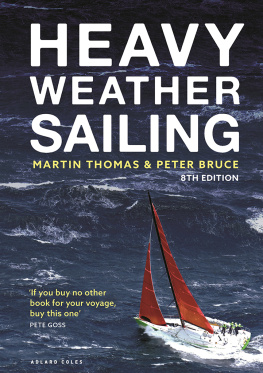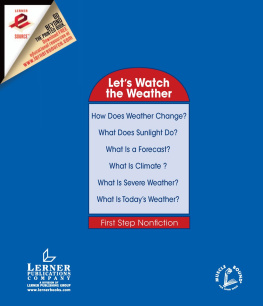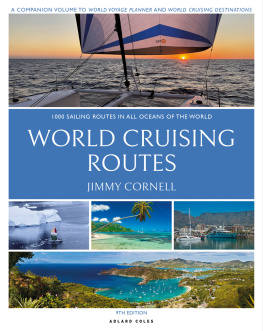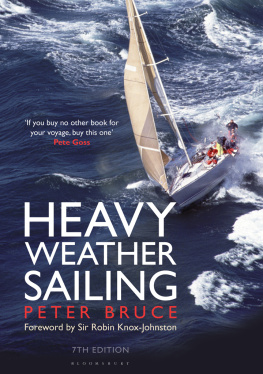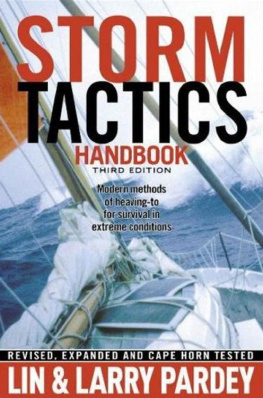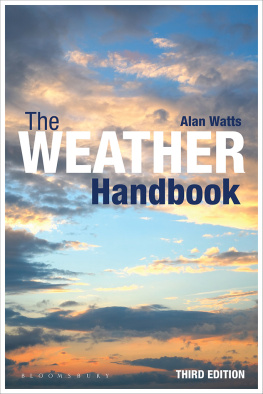
ADLARD COLES
Bloomsbury Publishing Plc
50 Bedford Square, London, WC1B 3DP, UK
29 Earlsfort Terrace, Dublin 2, Ireland
This electronic edition published in 2022 by Bloomsbury Publishing Plc
BLOOMSBURY, ADLARD COLES and the Adlard Coles logo are trademarks of Bloomsbury Publishing Plc
First published 1967
Reprinted 1968, 1971, 1973
Second edition 1975
Third edition 1980
Reprinted 1981, 1983, 1986, 1989
Fourth edition 1991
Reprinted 1992, 1994 (twice), 1996
Fifth edition 1999
Reprinted 2001, 2003, 2006
Sixth edition 2008
Seventh edition 2016
This edition published 2022
K Adlard Coles, 1967, 1975, 1980
Peter Bruce, 1991, 1999, 2008, 2016, 2022
Martin Thomas, 2022
Peter Bruce and Martin Thomas have asserted their rights under the Copyright, Designs and Patents Act, 1988, to be identified as Authors of this work.
All rights reserved
You may not copy, distribute, transmit, reproduce or otherwise make available this publication (or any part of it) in any form, or by any means (including without limitation electronic, digital, optical, mechanical, photocopying, printing, recording or otherwise), without the prior written permission of the publisher. Any person who does any unauthorised act in relation to this publication may be liable to criminal prosecution and civil claims for damages.
No responsibility for loss caused to any individual or organization acting on or refraining from action as a result of the material in this publication can be accepted by Bloomsbury or the author.
A catalogue record for this book is available from the British Library
Library of Congress Cataloguing-in-Publication data has been applied for
ISBN: 978-1-4729-9260-4 (HB)
ISBN: 978-1-4729-9259-8 (eBook)
ISBN: 978-1-4729-9258-1 (ePDF)
To find out more about our authors and their books please visit www.bloomsbury.com where you will find extracts, author interviews and details of forthcoming events, and to be the first to hear about latest releases and special offers, sign up for our newsletters.
Every effort has been made to contact the copyright holders of all images used within this book. If any errors or omissions have inadvertently been made, they will be rectified in future editions provided that written notification is made to the publishers.
Contents
Mervyn Wheatley
Randall Reeves
Jeff Dusting and Grant Dunoon
Tim Barker
Martin Thomas
Christopher Elliott
Francis Hawkings
Richard Heath
Peter Bruce and Rob Humphreys
Peter Bruce and Martin Thomas
Sheldon Bacon
Andrew Claughton
Simon Rowell
Susanne Huber-Curphey, Peter Bruce and Mark Orr
Peter Bruce and Peter Sanders
David Ridout
Gordon Kay and Hugh Welbourn
Frank Kowalski
Hugo Montgomery-Swan
Martin Thomas and Bob Shepton
Martin Thomas
Martin Thomas
Martin Thomas
Martin Thomas

Love & War, skippered by Peter Kurts, ploughs through rough seas off the east coast of Tasmania during the 60th Sydney to Hobart yacht race, 28 December 2004. PHOTO: DANIEL FORSTER/AFP/GETTY
Heavy Weather Sailing has a new editor, only the third in 55 years. When asked to succeed Peter Bruce I recognised the privilege I had been offered but also the huge responsibility. Adlard Coles first published his remarkable book in 1967 and gave us three editions. He demonstrated through his seamanship and his writing how to cope in rough weather and sailors were keen to learn. Peter Bruce has been at the helm for over three decades; few people know more about handling boats. His experience, advice, common sense, his passion for sailing are expounded in his fine writing. Over the years he has continued to incorporate into the book advances in boat design, some of which he has shown to be for the better and some not. Peter remains concerned that requirements for racing can compromise yacht stability and safety. His editions feature advice on good seamanship and crew safety, on improvements in boat handling under both sail and power and on new useful equipment. His style has made the skill of driving a boat in rough conditions accessible to all. He has elevated Heavy Weather Sailing to the authority that it has become. Happily, Peter has stayed on board and guided me through this latest edition, for which the reader must be grateful.
The Storm Experiences have been moved to the first section of the book. The immediacy of these personal accounts is powerful; they record the dangers faced and the resilience of the crews. Storm accounts that give personal experience of what are often tough events remain central to the book. Having read of the storms, chastened sailors may move on to the Expert Advice section in case they encounter such weather themselves. Over the years some storm accounts have taught sailors a huge amount, the 1979 Fastnet Race and the 1998 SydneyHobart Race are two such. These tragedies and the lessons learned from them are still referenced in these pages. More recent storm accounts show that the sea remains unpredictable and dangerous. Events where matters went wrong, or when mistakes occurred, often tell us more than those that were perfectly managed.
Every chapter in the Expert Advice section in this 8th edition has been updated and refreshed. In most instances loyal contributors such as Sheldon Bacon, Andrew Claughton, Hugo Montgomery-Swan and Mark Orr have re-written pieces to include new material recently available. Peter himself, for instance, has completely re-fashioned, with the help of Rob Humphreys, Yacht design for heavy weather. He has recruited Peter Sanders, the celebrated sailmaker, to help with Storm sails. Other chapters have new authors to provide fresh and modern views. The voyages of Susanne Huber-Curphey, so long alone in the rough seas of the worlds oceans, bring real authority. Frank Kowalskis experience of driving powerboats through breaking waves is second to none. These two authors light up the pages. David Ridouts fifteen years cruising the seven seas inform his valuable lessons on anchoring, mooring and taking refuge. Simon Rowell, who advises the Royal Ocean Racing Club (RORC) and the British Olympic Sailing Team, has written extensively on meteorology. He merges his expertise in sailing and in weather to bring an accessible account of such an important aspect of yachting. Foils can be considered the greatest innovation in yacht design since the catamaran. Gordon Kay and Hugh Welbourn inform us on how boats with foils behave in rough seas. All these new authors know what they are about and I am grateful to them for bringing their insights to this latest edition of the book.
While the best of the old must be preserved, it is important to bring forward the new. As well as the enhanced chapters on topics familiar in the book, new aspects related to heavy weather have been introduced. No boat can venture into high latitudes without meeting heavy weather. The crew will have to face rough conditions compounded by the special problems in those regions, such as ice and the sparsity of safe refuge. With the invaluable help of celebrated polar sailor the Reverend Bob Shepton, a chapter on high latitude sailing has been added. Thunder and lightning are associated with heavy weather. To be caught in a lightning storm at sea is a concern to any sailor; lightning is frightening. A new chapter on how to manage in a thunderstorm should be welcome. The yachts tender is uniquely important equipment and yet often neglected. The piece on tenders is there to raise awareness on how to handle a dinghy in heavy weather and give the little craft some proper consideration. When offshore, skippers rightly worry about medical emergencies affecting their crew and some guidance is given, not the comprehensive

